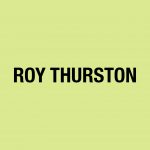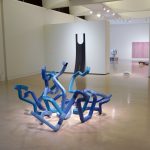Joshua Hashemzadeh: I know we have discussed in length how much of Los Angeles’s artistic legacy has been overlooked through the decades and it seems that curators, collectors, and academics are just now starting to unearth and appreciate the stories behind some of the city’s great artists and spaces, one of which being the F-Space gallery in Santa Ana during the 1970s. For those who may not be familiar with this artist-run space can you give us a brief overview of how it was formed and how Michael Brewster became affiliated with this cohort?
우리는 로스앤젤레스의 예술적 유산이 수십 년 동안 얼마나 간과되었는가에 대해
오랫동안 논의했습니다. 그리고 이제 큐레이터, 수집가 및 학자들이 이제 이 도시의 위대한 아티스트들과
공간에 대한 이야기를 발굴하고 감상하기 시작한 듯 보입니다. 그 중 하나가 1970 년대 산타 아나의 F-Space 갤러리입니다. 아티스트가 운영하는 이 공간이 익숙하지 않은 분들을 위해 그 공간이 어떻게
형성되었고 마이클 브루스터가 이 집단과 어떻게 연계되게 되었는지에 대해 간략하게 설명해
주시겠습니까?
H. C. Arnold: F-Space started in the early 1970s when Chris Burden asked several of his classmates at UCI to go in with him on a studio space in Saddleback Industrial Park in Santa Ana. UCI was relatively new then, and it did not have studio spaces for its graduate students. This was Burden’s solution. The idea was to have a self-contained artist space where its members would be free to experiment and probe at the question: “what is art?” It was named F-Space because each workspace was listed alphabetically. The initial members were Nancy Buchanan, Bruce Dunlap, Chris Burden, Gary Beydler, Margaret Wilson, George Williams, Robert Walker, Debbie Peck, Larry Shep, Kathy Mennaely, and Barbara Smith. They acquired the space in January of 1971. After the initial 6-month lease was up, the group began to change, assumedly because members had graduated from UCI and were moving on. At that point, membership was open to whoever wanted to chip in on rent and participate. Brewster knew Burden from their time at Pomona College and was asked to join. Brewster gladly agreed, and his first show there was in the summer of 1971.
F-Space 는 1970 년대 초에 크리스 버든이 UCI의 몇몇 반 친구들에게 산타 아나의 새들백
산업단지에 있는 스튜디오 공간에 함께 들어가자고 요청했을 때 시작되었습니다. 당시 UCI는 비교적 신흥
대학이었고, 그곳에는 대학원생을 위한 스튜디오 공간이 없었습니다. 이것이 버든의 솔루션이었습니다.
그의 아이디어는 “예술이란 무엇인가?”라는 질문에 대해 멤버들이 자유롭게 실험하고 조사할 수 있는
독립된 아티스트 공간을 확보하는 것이었습니다. 각 작업 공간이 알파벳순으로 나열되었기 때문에 F-
Space라고 이름 붙여졌습니다. 초기 멤버는 Nancy Buchanan, Bruce Dunlap, Chris Burden, Gary
Beydler, Margaret Wilson, George Williams, Robert Walker, Debbie Peck, Larry Shep, Kathy Mennaely 및
Barbara Smith였고, 그들은 1971년 1월에 공간을 확보했습니다. 초기 6개월 임대 기간이 지나면 새로운
그룹이 들어오기 시작했는데, 이는 아마도 멤버들이 UCI를 졸업하고 사회로 나갔기 때문일 것입니다. 이
시점에서 임대료를 같이 지불하고 참여하려는 사람은 누구나 멤버가 될 수 있었습니다. 브루스터는
포모나 칼리지 시절부터 버든을 알고 있었고 그 공간에 들어오라는 제안을 받았습니다. Brewster는
기꺼이 동의했고 1971 년 여름에 그는 첫 전시를 열었습니다.
F-Space gallery – Santa Ana, CA
Joshua Hashemzadeh: Baik Art’s exhibition, MICHAEL BREWSTER: FREQUENCY, presents a drawing done during that exhibition in 1971, I’m interested to know more about the relationship between Micheal’s drawing and his first acoustic sculpture pictured on that back wall of F-Space. Can you shed light on the significance of that drawing and how his piece, “Fixed Frequency” may have influenced the trajectory of his practice?
Baik Art의 전시인 MICHAEL BREWSTER: FREQUENCY는 1971년 전시회 도중
완성된 드로잉을 발표합니다. 저는 마이클의 그림과 F-Space의 뒷벽에 그려진 그의 첫 번째 음향 조각품
사이의 관계에 대해 더 알고 싶습니다. 그 그림의 중요성과 그의 작품 “Fixed Frequency (고정된
주파수)”가 그의 관례의 궤적에 어떤 영향을 미쳤는지에 대해 설명해주실 수 있나요?
H. C. Arnold: So, a few things about all this. As the only art-historian working on Brewster, my research indicates he did not show this drawing at his first exhibition at F-Space. In fact, I’m not sure if it was shown publically during his lifetime. It’s a unique insight into his working method. Further, as for the drawing’s relationship to his first-ever acoustic sculpture, Fixed Frequency (its’ speaker visible along the back wall of Burden’s image of Shoot), I discovered it is a frequency plot of that piece. So, what we see are the various decibel readings of Fixed Frequency active in F-Space. Brewster was learning about standing waves at this time, and I assert this drawing is part of that self-education as well as a unique documentation of the work. This learning about sound waves ends up leading to his entire body of “acoustic sculptures,” a selection of which Baik Art is currently showing.
이 모든 것에 대해 몇 가지 말씀 드리겠습니다. 브루스터에 대해 작업하는 유일한
예술사로서, 저의 연구는 그가 F-Space에서 열린 그의 첫 전시회에서 이 드로잉을 보여주지 않았다는
사실을 보여줍니다. 사실, 그의 생전에 그것이 공개적으로 공개되었는지는 확실하지 않습니다. 이는 그의
작업 방식에 대한 독특한 통찰력입니다. 또한, 그의 최초의 음향 조각품인 “고정된 주파수” (버든의 Shoot
이미지 뒷벽을 따라 보이는 스피커)와 드로잉의 관계에 대해 저는 이것이 그 작품의 주파수 플롯이라는 걸
발견했습니다. 따라서, 우리가 보는 것은 F-Space에서 활성화되는 “고정 주파수”의 다양한 데시벨
판독값입니다. 브루스터는 그 당시 스탠딩 웨이브에 대해 배우고 있었고, 저는 드로잉이 그러한 독학의
일부일 뿐만 아니라 작품에 대한 독특한 문서화라고 단언할 수 있습니다. 이 음파에 대한 배움은 결국 Baik
Art가 현재 전시하고 있는 “음향 조각품”의 전신으로 이어집니다.
Joshua Hashemzadeh: It’s pretty remarkable that so many important artists were all able to link up at that time to create such an innovative space. Considering LA’s history with venues, artists, and thinkers who broadened the artistic canon, why do you think so much of the cities contributions from artists, like Michael Brewster, have largely been overlooked in the latter part of the 20th century?
그 당시 많은 중요한 아티스트들이 그와 같은 혁신적인 공간을 만들기 위해 서로
동맹을 맺을 수 있었다는 것은 매우 놀라운 일입니다. 장소, 아티스트 및 예술적 정경을 넓힌 사상가와
LA의 역사를 고려할 때 왜 마이클 브루스터와 같은 아티스트가 도시에 공헌했던 많은 기여가 20세기
후반에는 간과되었다고 생각하십니까?
H. C. Arnold: I think New York took the spotlight for a long time. However, this has begun to change recently. The Pacific Standard Time initiative by the Getty is a good example. Their first round of exhibitions under the broad project titled “Los Angeles Art 1945- 1980” hosted a variety of exhibitions that put a spotlight on what Los Angeles offered between those years. My hope is that this city’s artistic legacy will continue to be explored and contextualized over time. Exhibitions such as this one are a great step in that direction.
뉴욕이 오랫동안 주목을 받았기 때문이라고 생각합니다. 그러나 이는 최근에 변하기
시작했습니다. 게티의 태평양 표준시 계획이 이에 대한 좋은 예입니다. “Los Angeles Art 1945-
1980”이라는 광범위한 프로젝트 하에서 열린 그들의 첫 전시회는 그 기간 동안 로스앤젤레스가 제공한
것을 조명하는 다양한 전시회를 주최했습니다. 저는 이 도시의 예술적 유산이 시간이 지남에 따라 계속
탐구되고 맥락화되기를 바랍니다. 이와 같은 전시회는 그 방향으로 나아가는 큰 발걸음입니다.
Additional Content
Michael Brewster: Frequency | Michael Brewster | January 18 – March 14, 2020 | press release | catalogue
FELIX ART FAIR | Ross Rudel, Carol Kaufman, Lies Kraal, Syagini Ratna Wulan, Michael Brewster | February 13 – February 16, 2020 | catalogue
collaborators













